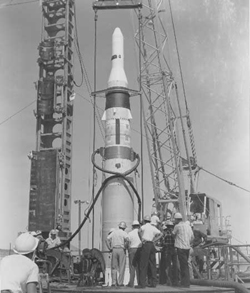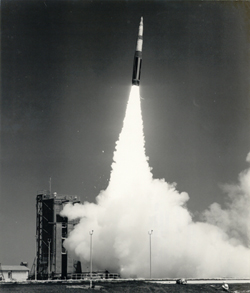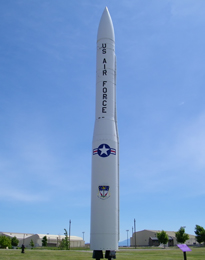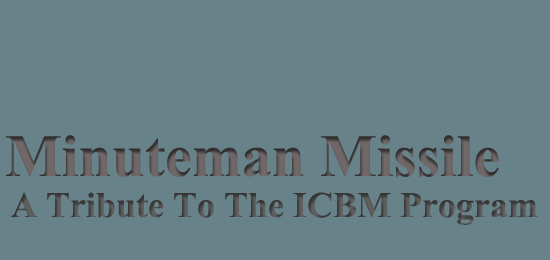
Minuteman I Test - Edwards AFB

Minuteman I Launch
Minuteman I Missile A/B
The Boeing LGM-30A Minuteman I ICBM was the first ICBM to use solid fuel rather than the liquid fuel of its predecessors, the Atlas and Titan Intercontinental Ballistic Missiles. The Minuteman missile is a smaller delivery vehicle and easier to maintain, and due to its solid rocket propellant, this missile can be launched quickly.
In January 1955, the USAF Western Development Division was developing both the liquid fueled Atlas and Titan missile systems, and the WDD made funding available to explore alternative ICBM designs. By mid 1957 the Air Force initiated a study into solid-propellant rocket motors for use on ICBMs, and the secret development of a vehicle called "Missile Q" unfolded. This new ICBM would soon become known as the Minuteman.
Colonel Edward Hall was the man responsible in designing and developing the new Minuteman ICBM. In February of 1958 the AFBMD, Air Force Ballistic Missile Division, (formerly called the Western Development Division) sent Col. Hall to Washington DC to convince the Secretary of Defense, the Secretary of the Air Force, and General Curtis Lemay, commander of the Strategic Air Command, SAC, that the Minuteman missile was the ICBM worthy of development.
On February 27, 1958 Congress officially gave the USAF the go ahead to begin the research and development of the Minuteman. Congress was impressed with the program and initially allocated $50 million to the AFBMD and promised them an additional $100 million if they could prove that the Minuteman was indeed a feasible missile for the ICBM program. A total of seventeen aerospace companies were asked to submit bids for the ICBM project, and fourteen responded with design proposals. On October 9, 1958 the Boeing Aircraft Company was designated as assembly and test contractor for the Minuteman program.
Following Boeing being granted the missile assembly and testing contract, the AFBMD awarded the guidance computer contract to the Autonetics Division of North American Aviation and the reentry vehicle contract went to AVCO Corporation. The contract for developing the first, second and third stage rocket motors went to Thiokol, (first stage) Aerojet General, (second stage) and Hercules, which developed the third stage solid-fueled rocket motor.
In April 1959 the Cold War was beginning to increase in intensity, which prompted the Secretary of Defense to order that the Minuteman program be accelerated by one year. In September 1959 the AFBMD was successful at launching a Minuteman first stage motor directly from an underground silo. Boeing and the Air Force Ballistic Missile Division began launching mockup Minuteman missiles at Edwards Air Force Base in California, and all launches were successful leading up to May 1960. In August 1960 the AFBMD attempted to launch a Minuteman with all three stages from a silo, and were not successful. Initially Boeing had a total of 18 Minuteman mockup launches, but the launches had proved to be so successful, the Air Force ended the testing after the 8th launch.
March 26, 1960 marked the date when the Defense Department authorized production of 150 Minuteman I/A missiles, with the goal to have these missiles deployed in six missile wings by 1963. The "I/A" missile was given this title due to a flaw in the first stage rocket motor, which reduced the range of the missile by 2000 miles. Opting not to delay the entire Minuteman program while it corrected this problem, the Air Force opted to go ahead and deploy a total of 150 Minuteman I/As.
As the development of the Minuteman missile continued, the Army Corps of Engineers Ballistic Missile Construction Office, CEBMCO, were appointed the task of building the launch facilities (missile silos) and launch control centers. Construction for the Launch Facilities and Launch Control Facilities started in March 1961 at the first Minuteman missile wing at Malmstrom Air Force Base in Great Falls, Montana. Construction was completed that following fall, September 1961. On October 22, 1962, the Strategic Air Command placed its first flight of ten Minuteman I/A missiles on operational alert. The 10th Strategic Missile Squadron at Malmstrom AFB was called upon to take on this role during this historical time. The Cold War was ramping up between the United States and the USSR. The Alpha 01 LCF, also known as the "Ace In The Hole" Launch Control Facility, attached to the 10th SMS, (Strategic Missile Squadron) stepped up to the plate during the Cuban Missile Crisis, and were the first of the Minuteman ICBM program that stood ready with their Minuteman I missiles during this profoundly intense time.
Only two other Model A Minuteman I squadrons were activated by the SAC. These were the 12th Strategic Missile Squadron, which was activated on the first of March, 1962 and the 490th Strategic Missile Squadron, which was activated on the first of May, 1962, both squadrons were also located at Malmstrom AFB. The next thirteen Minuteman I missile squadrons activated by the SAC were all model "B" Minuteman missiles. In the summer of 1963 the Minuteman I/A was renamed the Minuteman LGM-30A, with the Minuteman I/B designated as the Minuteman LGM-30B.
The difference between the Minuteman LGM-30A and LGM-30B missiles was that the first stage of the LGM-30A's solid fuel rocket booster had a flaw that limited the range of the missile by 2000 miles. The LGM-30B missile had a redesigned first stage motor, and was also fitted with a new second stage motor that was fitted with a titanium motor casing. The LGM-30A casing was made of stainless steel. With the LGM-30B missile, it not only came with increased power and range, but this missile also came with a MK-II W59 reentry vehicle (warhead) with a yield of 1.2 Mt,(Mt = megaton). The LGM-30A was fitted with a MK-5 W59 warhead with a yield of 1 Megaton. The LGM-30B Minuteman had a new guidance computer, which made the missile capable of being programmed with two targets, compared to the one target capability of the LGM-30A Minuteman. The "L" indicates that the missile is silo launched, the "G" indicates that it is designed to attack surface targets and the "M" indicates that this is a guided missile. Cost of each Minuteman I missile was $1,315,000.
Deployment of the Minuteman missile force was accomplished with mind boggling speed. The Minuteman Launch Facilities were much smaller and easier to build then the Atlas and Titan Launch Facilities. It is recommended that you read "To Defend and Deter" to grasp the magnitude of both the Atlas and Titan ICBM programs and the effort placed in deploying these two ICBM missiles programs. With the Minuteman missile, the CEBMCO was able to use prefabricated components and standardized construction techniques, and as a result were able to construct 1000 missile silos by 1966. The man power, effort and sheer magnitude of the ICBM program during the early to mid sixties has yet to be repeated by the United States.
By July 1963 a total of 150 Minuteman I missiles were placed on operational alert, by October 1963 that number increased to 300 missiles, 450 missiles were deployed by March 1964 and in June 1965 F.E. Warren Air Force Base in Wyoming, placed the 800th Minuteman I missile on operational alert. The decision regarding the final size of the silo based Minuteman Intercontinental Ballistic Missile force was not made until December of 1964. A new system directive was issued on December 11, 1964, stating that the final Minuteman force would be a total of 1000 missiles.

